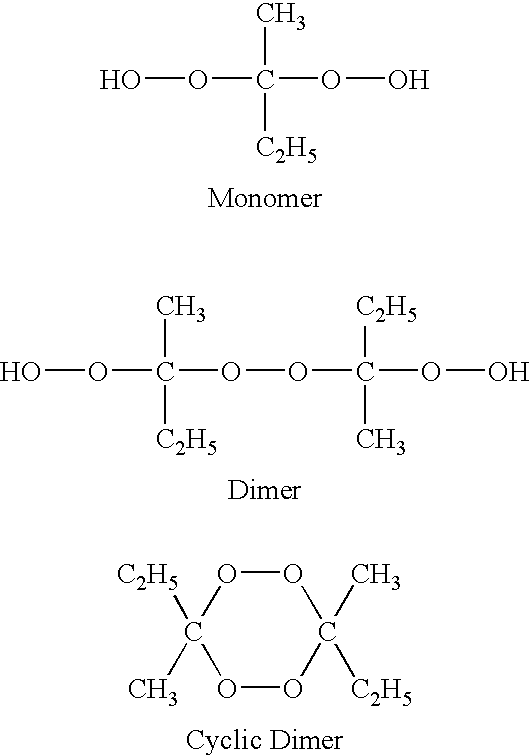Use of dialkylketone peroxide as biocidal, sterilizing, antiseptic, disinfecting and anti-parasitic agent
a technology of dialkylketone peroxide and biocidal agent, which is applied in the direction of antiparasitic agent, drug composition, detergent compounding agent, etc., can solve the problems of corrosive to certain metallic instruments, damage to instruments sensitive to heat, and inability to use culture medium or protein solution,
- Summary
- Abstract
- Description
- Claims
- Application Information
AI Technical Summary
Problems solved by technology
Method used
Image
Examples
example 1
Bactericidal Activity
[0064] Three solutions of methyl ethyl ketone peroxide were prepared at 0.06%, 0.125% and 0.25% (v / v) by diluting Butanox M-50 (approximately 33% methyl ethyl ketone peroxide; w / v) in sterile hard water (300 mg / l of CaCO3). A neutralising solution of thioglycolate was added at 0.5%, in this way producing three clear and colourless solutions.
[0065] Each of the aforementioned solutions was brought into contact with distinct bacterial strains for 5, 15 and 30 minutes at a temperature of 20° C. (Pseudomonas aeruginosa ATCC 15442, Escherichia coli ATCC 10536, Staphylococcus aureus ATCC 6538, Enterococcus hirae ATCC 8043 and Legionella pneumophila ATCC 33152) and incubated at 20° C.
[0066] The data from the validation assays are shown in Table I and the results of the bactericidal activity of each one of the three methyl ethyl peroxide solutions are shown in Table 1.
TABLE IValidation AssayControl ofToxicitythe method ofExperimentalcontroldilution-conditionsof then...
example 2
Fungicidal Activity
[0070] Three solutions of methyl ethyl ketone peroxide were prepared at 0.06%, 0.125% and 0.25% (v / v) by diluting Butanox M-50 (approximately 33% methyl ethyl ketone peroxide; w / v) in a sodium chloride / tryptone solution. A solution of thioglycolate (0.5%) was added as a neutralising agent.
[0071] Each of the solutions was brought into contact with the fungal strains Candida albicans ATCC 10321 and Aspergillus niger ATCC 16404, for 5,15 and 30 minutes at a temperature of 20° C. and incubated at 30° C.
[0072] The data from the validation assays are presented in Table II and the results of the fungicidal activity of each of the three solutions of methyl ethyl ketone peroxide are laid out in Table 2.
TABLE IIValidation AssaysValidationToxicityassay of theof themethod ofneutral-neutral-TestFungalExperimentalisingisation-organismsuspensionconditionsagentdilutionAspergillusVc 20; 70Vc 70; 20Vc 60; 50Vc 130; 90nigerNv 4.5 × 102A 4.5 × 101B 5.5 × 101C 1.1 × 102ATCC 16404...
example 3
Sporicidal Activity
[0076] Three solutions of methyl ethyl ketone peroxide were prepared at 15%, 20% and 25% (v / v) by diluting Butanox M-50 (approximately 33% methyl ethyl ketone peroxide; w / v) in a sodium chloride / tryptone solution. Each of the solutions was brought into contact with a suspension of Bacillus subtilis spores ATCC 19659, for 5, 15 and 30 minutes at a temperature of 20° C., incubated at 35° C., and placed on a carrier disc in the presence of mucin and bovine serum albumin.
[0077] Method used: A carrier disc according to the norm ASTM E-2197-02. Standard Quantitative Disk carrier test method for determining the bactericidal, virucidal, fungicidal, mycobactericidal and sporicidal activities of liquid chemical germicides. ASTM International, Pa, USA.
[0078] Suspension of Bacillus subtilis spores
ATCC 19659 of the assay8.6 × 102 CFU / mlControl of the suspension in the presence8.1 × 102 CFU / mlof mucinControl of the suspension in the presence7.2 × 102 CFU / mlof bovine serum ...
PUM
| Property | Measurement | Unit |
|---|---|---|
| temperature | aaaaa | aaaaa |
| v/v | aaaaa | aaaaa |
| v/v | aaaaa | aaaaa |
Abstract
Description
Claims
Application Information
 Login to View More
Login to View More - R&D
- Intellectual Property
- Life Sciences
- Materials
- Tech Scout
- Unparalleled Data Quality
- Higher Quality Content
- 60% Fewer Hallucinations
Browse by: Latest US Patents, China's latest patents, Technical Efficacy Thesaurus, Application Domain, Technology Topic, Popular Technical Reports.
© 2025 PatSnap. All rights reserved.Legal|Privacy policy|Modern Slavery Act Transparency Statement|Sitemap|About US| Contact US: help@patsnap.com


